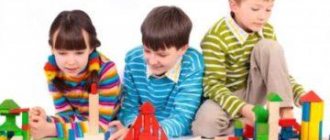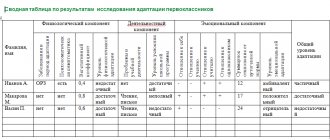School maladjustment is a child’s mental state, manifested by problems with discipline, learning, behavior, relationships with peers and adults. There are many options for the manifestation of maladjustment, as well as reasons. But the basis of maladaptation is the child’s inability to accept a new role and a new developmental situation.
Maladaptation most often occurs in primary school students, but also occurs when moving from junior to middle school and from middle to high school, or when changing place of education. In adolescence, this is often a consequence of previously unnoticed problems with adaptation. The task of parents and teachers is to identify maladaptation in time and help the child.
Diagnostics
Several methods can be used to diagnose school maladjustment. I propose to consider an observation map for diagnosing all ages and separately methods for primary schoolchildren and adolescents.
Observation map
D. Stott's observation card is a ready-made form with statements, in which it is proposed to enter answers about the correctness of these statements regarding a particular child. A total of 16 blocks are presented, that is, all symptoms are divided into symptom complexes. This allows us to establish the features of maladjustment:
- distrust of people, things, situations;
- depression;
- withdrawal;
- anxiety in relationships with adults;
- hostility in relationships with adults;
- anxiety regarding peers and other children;
- asociality;
- hostility towards children;
- restlessness and restlessness;
- emotional stress;
- signs of neuroses;
- unfavorable development conditions;
- problems in the field of sexual development;
- mental retardation;
- diseases and pathologies;
- physical disabilities.
The points determine the fact of maladjustment, the severity of each symptom complex and its role in maladjustment. The card can be used for both primary schoolchildren and teenagers.
This is an extensive and multifunctional (quality and quantity, congenital and acquired causes, severity of individual causes) method for studying maladjustment. But the disadvantage of the technique is that a more complete observation can only be carried out by a school specialist, but even then not always, subjective errors in the assessment are possible. In addition, this is a time-consuming method to implement.
Junior schoolchildren
To diagnose younger schoolchildren, especially first-graders, the questionnaire of L. M. Kovaleva and N. N. Tarasenko is often used. The technique is also focused on observation of the child by teachers, but as in the first case, any adult who knows the child well can answer the questions.
The questionnaire includes 46 questions, which are divided into blocks (possible causes and factors of maladjustment):
- parental attitude towards the child;
- readiness (unreadiness) for school;
- left-handedness;
- neuroses and neurotic symptoms;
- infantilism;
- hyperkinetic syndrome (impaired attention, hyperactivity and impulsivity), excessive disinhibition;
- inert nervous system;
- weak voluntary mental functions;
- lack of educational motivation;
- asthenic syndrome;
- intellectual disabilities.
The maladjustment coefficient is calculated. Among the possible options: normal adaptation, average degree of maladjustment, severe maladaptation, indications for visiting a neuropsychiatrist (congenital problems).
Teenagers
When diagnosing adolescents, you can use complexes of diagnostic techniques to analyze individual areas:
- personality accentuation tests;
- Phillips anxiety test;
- method “Home. Tree. Human";
- method of unfinished sentences;
- SAN questionnaire (well-being, activity, mood);
- Thomas test (behavior in conflicts);
- Q-sort (self-esteem analysis);
- SMIL (standardized multifactorial method of personality research);
- test of value orientations;
- T. Leary “Diagnostics of Interpersonal Relationships”;
- Furman A. “How adapted are you to life.”
Observations about the maladjustment of adolescents indicate:
- Developmental delay, with the exception of mental retardation.
- Problems in mastering school knowledge and academic performance.
- Underdevelopment of speech, problems in the form of insufficient vocabulary, difficulty in generalizing, systematizing and other functions of speech. Weakness of inner speech.
- Lack of cognitive activity, curiosity and verbal-semantic memory.
- Aggression towards people, things, animals.
- Feelings of inferiority.
- Excitability and conflict.
- Inadequate self-esteem.
- Running away from home and/or school.
- Deviant behavior.
Both among younger schoolchildren and among teenagers, the composition method can be used to determine their true motives, needs and interests (for younger children - a fairy tale, for older children - a story).
Causes of school maladjustment
Psychologists studying the phenomenon of maladjustment identify the following among the main reasons:
- strong suppression by parents and teachers - overprotection (fear of failure, shame, fear of making mistakes);
- disorders of a somatic nature (weak immunity, diseases of internal organs, physical fatigue);
- poor preparation for school (lack of certain knowledge and skills, poor motor skills);
- poorly formed foundation of some mental functions, as well as cognitive processes (inadequately high or low self-esteem, inattention, poor memory);
- specifically organized educational process (complex program, special bias, fast pace).
Correction
A popular mistake in working to correct maladjustment is fighting the symptoms that have appeared. For example, a child asserts himself through fights. It is useless to punish him for fighting and prohibit him from doing so. Even if he stops fighting, he will do something else, for example, vandalism, since the need for self-affirmation will remain, and the child still does not know the correct methods. Accordingly, the goal of the work is to help the child assert himself in a socially acceptable way.
So what can you do:
- Identify the child’s abilities and interests.
- Identify problems that accompany the need for self-affirmation, for example, uncertainty or fears.
- Help the child overcome problems and do useful and interesting things, for example, join a club, take up drawing or sports, play KVN, and so on.
Using the same principle, you need to work with a child’s aggression and rudeness. Perhaps this is an overcompensation for self-doubt and inability to communicate. Accordingly, we teach how to communicate and be confident - rudeness goes away on its own.
Correction of maladjustment requires an individual approach, which takes into account:
- age characteristics;
- individual personal characteristics;
- manifestations and root causes of maladjustment;
- development environment conditions.
There is no need to be afraid of maladaptation, much less to hush up the problem. Problems in adaptation occur in 15-40% of schoolchildren. Unfortunately, this is a popular problem, but in the early stages it can be easily corrected.
The work should be carried out jointly by parents and school specialists:
- the psychologist draws up recommendations and an individual development plan for the child;
- parents monitor compliance with recommendations within the home (assistance in mastering knowledge, control over the completion of lessons, analysis of missed or incomprehensible material);
- The teacher helps the child in the classroom: creates situations of success, monitors the healthy psychological climate and adherence to an individual-personal approach.
An important role in correcting a child’s maladaptation is played by the individual personal qualities of adults (parents and teachers) and the nature of their interaction. It is important to remember the overall goal - to help the child adapt. The unity of parents and teachers helps to at least reduce the level of anxiety in the child.
Junior schoolchildren
Primary school students are just beginning to move from gaming to educational activities, so games are an excellent form of assistance in adaptation:
- If we are talking about problems in relationships with the team, then games for unity.
- For the development of cognitive processes - intellectual games.
Unity games:
- Orchestra. The game is played by analogy with real conducting: the presenter (conductor) raises and lowers his hands. The higher he raises them, the louder the other children (orchestra) perform the chosen action.
- “Let the one who...” The leader goes to the center of the circle and says, “Let the one who likes to play football (for example) come out to me.” You can name any word: an item of clothing, a hobby, external features.
Educational games should be selected depending on the area in which the gap is noted. Here are some examples:
- For the development of short-term memory. The child is asked to look for 20 seconds at a sheet with drawn figures, remember them and then repeat them on a blank sheet of paper.
- Associations. The child is asked to connect pictures and words according to their meaning, and then give reasons for their decision.
- The “Complete the picture” technique will allow you to determine your creative potential. The child is offered a set of identical (simple level) or different (difficult level) blank figures and is required to complete them. There are no other restrictions. Not only the result of the work is assessed, but also activity, variability, speed of thoughts and actions.
Teenagers
The best method for correcting maladaptation in a teenager is to help him achieve self-realization. To do this, you need to have conversations, organize joint and interesting activities for the teenager, respect his personality and sense of adulthood.
Creativity therapy has proven itself positively. The type of occupation is selected individually. For example, if the problem is not only socio-psychological (uncertainty), but also in the cognitive sphere, then activities that require concentration and develop fine motor skills (sewing, embroidery, weaving) are suitable.
In order to unite the class, it is necessary to use trainings and group consultations. Work should be aimed at developing empathy, reflection, independence (including self-organization).
For example, you can follow this training plan:
- Warm-up and introduction (half an hour). Children get to know each other by playing “Hot Ball”: they throw a ball to each other, say their name and give a compliment to the other person (to whom they throw). Then the leader assesses the readiness of the entire group, the activity of individual participants, and the characteristics of the group’s composition. The game “Arrow” will help with this: the group needs to imagine that they are an arrow (scale), and move towards the maximum or minimum as much as they are ready to work, cheerful, healthy, and so on. Well, in conclusion, the presenter names the topic of the training, voices the problem and describes the essence and goals of the lesson.
- Main part. Depending on the specific conditions, relaxation with the release of the subconscious and imagination, situational role-playing games, simulation games, psychological studies, psychodrama, discussions, metaphors, drawing, and so on are used.
- Reflection. The results of the training are summed up, plans are made for the next lesson (7-8 lessons in total), the thoughts and feelings of the participants are discussed.
Conducting the training is permissible only by a specialist! This method has its own technology and a number of nuances.
General recommendations
Regardless of the child’s age, it is the responsibility of parents, psychologists and teachers to:
- Cooperate with the child, pay more attention, play, advise, observe.
- Preparing a child for school: working on the development of all types of thinking, developing fine motor skills, working on voluntary attention.
- Avoid high expectations and demands, allow the child to be imperfect and make mistakes. Sincerely notice successes without ridicule.
- Do not compare your child with other students, especially more successful ones. A child's success can only be assessed in relation to his previous successes.
- Help the child find a reference group and activities for self-realization. Additional education that matches the interests and capabilities of the child will give self-confidence due to the attention, success, and emotional support that the child will receive in this area. Gradually, self-confidence will spread to all areas of life.
- Make important the area in which the child has better success. Gradually, the attitude “If I am so good here, then I can succeed in another matter” will form.
It must be remembered that any word from an adult has educational power and corrects the behavior and thinking of the student. Both praise and scolding, shouting are tools of reinforcement and provocation to one or another response behavior.
Prevention
Primary School
Before a child enters school, he undergoes a psychological, medical, and pedagogical commission, which determines readiness for school, health status, and provides recommendations on the child’s individual development path.
Many parents are afraid of the commission, considering it an insulting event and seeing the risks of diagnosing their child. As a result, they refuse to pass. They have the right, but you need to understand that the commission members work in the interests of the child and family.
In order to prevent maladaptation, you cannot send a child who is not psychologically prepared to school, even if he is 6-7 years old. According to the laws of our country, the maximum age a child can be sent to school is 8 years old. The second option is to identify gaps in the readiness structure in advance and work with the child to prepare him for school.
Younger and older teenagers
Adolescence itself is characterized by personality maladaptation in a broad sense. The teenager is actively learning about himself and looking for his place. The best thing parents can do to prevent school maladaptation is to communicate with the teenager, treat him with respect and understanding, study the characteristics of age and the specifics of reactions.
What else can you do:
- Do not demand good grades and success in all subjects from your child.
- Help your teenager understand his interests and abilities and create an individual learning plan.
- Be lenient with the cognitive decline that is natural for this age, and help with nutrition, joint activities and rest.
Transfer from one institution to another
Changing your usual lifestyle is stressful for any person. Moving from one school to another is double stress for a child, especially if it is combined with a change of place of residence or occurs during transition classes. Joining a team is not an easy task:
- Meet and talk with the class teacher. Tell us about your child's characteristics and successes at the old school.
- Find out the features and charter of the school, introduce your child to the school in advance.
- It is useful to help a student in elementary school find friends - a neighbor at his desk, a member of a circle. Teenagers form groups themselves; there is no need to interfere. But you must always be ready to help and talk to your child.
Transferring from one educational institution to another is an individual event. It is impossible to predict the development of events, since everything depends on the characteristics of the child, school and class. Recommendations should be made for a specific case. The best thing parents can do to improve their child’s adaptation is to contact a local psychologist.
PSD development process
To describe the process of development of psychogenic school maladaptation Kagan E.V. gives the following diagram. In his opinion, in the process of PSD, asthenic disorders predominate, which first manifest themselves in the field of learning and are very easily compensated for in extracurricular activities. At this stage, psychological defense reactions appear; if they do not resolve the difficulties that have arisen, the situation is aggravated by the expansion of the field of reaction to out-of-school behavior. Further, fatigue, headaches, sleep disorders, appetite (somato-vegetative manifestations) can become regular, and with the weakness of certain brain structures, they can also turn into the form of systemic neuroses with possible disorders of digestion, breathing, and then the cardiovascular system, etc.
Afterword
If the child is happy with school and his whole life, then there will be no problems. This means that all work should be aimed at developing a positive attitude of the child towards life, himself, the environment, school and all participants in the educational process. Any activity that is significant to the child’s personality and gives him positive emotions, including communication as a separate activity, will help with this.
Read more about successful school adaptation, its signs and the role of parents in this, in the article “Psychological features of a child’s adaptation to school. Types and levels of adaptation." About the signs and factors of maladaptation - in the article “School maladjustment: what is it, causes and signs.”
Types of manifestation of school maladjustment
1. Cognitive – manifests itself as the student’s general poor performance. There may be chronic underachievement, lack of skills, fragmentary acquisition of knowledge. Lack of adaptation to the collective pace - being late for lessons, taking a long time to complete a task, getting tired easily.
2. Emotionally - evaluative - there are violations of the emotional attitude towards individual lessons, teachers, and possibly to learning in general. “Fear of school” is a child’s reluctance to go to class, anxiety, tension. Uncontrolled manifestation of violent emotions.
3. Behavioral – weak self-regulation, inability to control one’s own behavior, aggression and conflict appear. Lack of learning motivation manifests itself in a reluctance to do homework and a desire to engage in other activities.







